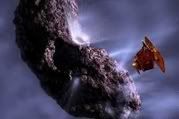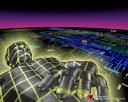DEEP IMPACT
Cosmic Crash Won't Destroy Comet or Earth
Leonard David
BOULDER, Colorado - Late Sunday and early Monday, skywatchers might be treated to celestial fireworks unlike anything witnessed before.
 Like some Space Age equivalent of WrestleMania, NASA's Deep Impact spacecraft is double-billed to tangle with Comet Tempel 1 on July 4. The mission is a two-part project: A "Flyby" vehicle will unleash an "Impactor" probe that will slam into the fast-moving comet.
Like some Space Age equivalent of WrestleMania, NASA's Deep Impact spacecraft is double-billed to tangle with Comet Tempel 1 on July 4. The mission is a two-part project: A "Flyby" vehicle will unleash an "Impactor" probe that will slam into the fast-moving comet.
The comet and Impactor will collide at about 23,000 mph.
Deep Impact is the first mission to make contact with a comet's surface. The hope is to produce a crater in the large comet and reveal what is underneath the surface.
The event could be visible from backyards. But for some, the novel space shot conjures visions of comet chunks careening into Earth. Is there any chance that Deep Impact will result in icy lumps of the comet splitting off, placing our planet in danger?
Put your crash helmets back in the closest and get some sleep.
Comet kamikaze mission
"We're sending a bug onto the windshield of a train," said Monte Henderson, Deputy Director of Programs in Civil Space Systems for Ball Aerospace & Technologies Corporation here.
Ball Aerospace, in association with the University of Maryland and NASA's Jet Propulsion Laboratory (JPL), developed and integrated the Flyby spacecraft, the Impactor spacecraft, and science instruments, including three telescopes, three cameras and a spectrometer for analyzing the interior of the comet - as revealed by the high-speed run-in.
Comet Temple 1 is moving at a brisk 66,000 miles per hour. The ejected Impactor is slated to be speeding at roughly 43,000 miles per hour. Deep Impact won't have a head-on crash with the comet, like the old anti-ballistic missile defense adage of "hitting a bullet with a bullet".
"We're being overrun from behind," Henderson told SPACE.com. "The speeds are just mind-boggling."
Telescopes onboard the Flyby vehicle will be trained on the Impactor as it is overtaken by the comet. The intent is to see crater formation as it's occurring, Henderson said. Scientists expect to see a crater shaped that's a 100 yards long, and between seven to twelve stories deep, "with nice vertical walls," he said.
In the event that the Impactor isn't successfully ejected by the Flyby spacecraft, then the entire vehicle is on a true comet kamikaze mission. It is to pile-drive itself into the comet, Henderson said. "It's important to the science community that we create a crater."
"This is a one-time exciting event," Henderson explained.
Simulation of a natural event
The excavation of the comet by Deep Impact may create a cloud of meteoroids, objects larger than the gas and dust that NASA predicts. And that possibility might not be so unnatural, contends Peter Jenniskens, an astronomer with the SETI Institute in Mountain View, California.
In a paper accepted for publication in the September issue of the Astronomical Journal, Jenniskens and co-author Esko Lyytinen, an amateur astronomer and meter shower expert from Finland, report that as a result of Tempel 1 breaking, a meteoroid stream will be created "in much the same manner as the mechanism that causes most of our meteor showers."
Jenniskens has been studying the formations of meteoroid streams by the disintegration of comets. He points to the idea that many meteoroid streams are caused by wholesale disintegration of comets, which are loose assemblages of cometesimals and are known to frequently break apart.
There are several possible causes of such fragmentations. But the idea that collisions between comets and large meteoroids spark such fragmentation is on the table, Jenniskens said. Furthermore, the Deep Impact mission acts as a simulation of such a natural event.
"Depending on how the kinetic energy of the impact will be distributed, there is a real possibility that sufficient internal gas pressure builds up to break the comet apart. At that time, we can study the peculiarities of dust generation in the way that led to our main meteor showers," Jenniskens and Lyytinen conclude. They also predict that the dust production will be moderate.
Risk to Earth?
There is a "way outside chance" that Deep Impact will promote an explosive release of built-up, sub-surface gas pressure, said Donald Yeomans, Supervisor of the Solar System Dynamics Group at the Jet Propulsion Laboratory (JPL) in Pasadena, California.
Yeomans said in the event that any meteoroid material is released, it will be modest and come no where near the Earth. (Meteor showers on Earth develop when Earth passes through a stream of comet debris.)
"So a modest meteoroid stream might be created that would follow the parent comet but no visible meteors would result of course," Yeomans said. "Perhaps an enhanced meteoroid stream following the comet might be discernable in pre- and post-impact infrared images. It would be unlikely, but not out of the question," he explained.
But given that the Impactor and Tempel 1 will bang into each other at a force of four-and-a-half tons of TNT, why wouldn't that explosive energy toss out huge bits of comet...splinters that could head toward Earth?
"The bottom line is that we have an object the size of a washing machine colliding with a comet the size of Manhattan Island. No contest," Yeomans said.
If Comet Tempel 1 happened to be smaller, say roughly 500 feet (150 meters) across as opposed to its true average diameter of 4 miles (6 kilometers), the Deep Impact crash would be sufficient to adjust the comet's course by an amount equal to Earth's radius ten years after the spacecraft impact, Yeomans told SPACE.com.
Mitigation techniques
Yeomans and his colleagues have done some calculations, just to help put worries about the risk to Earth to rest. They assumed a 98-foot (30-meter) chunk was broken off as a result of the impact. That size was selected as the smallest chunk that might cause some ground damage at Earth.
But for that chunk to be propelled into a new Earth-crossing trajectory, Deep Impact would need to impart a wallop that must be, well, simply astronomical. Furthermore, for the same impact velocity as Deep Impact, the impacting spacecraft mass would then have to about 5,900 times the mass of the actual Impactor.
"On a number of levels, it would be impossible for Deep Impact to deliver a comet chunk to Earth," Yeomans concluded.
While the primary science goals for Deep Impact do not include a demonstration of possible mitigation techniques, Yeomans said that the rather sophisticated autonomous navigation process used to impact the comet would be similar to those necessary to mitigate a threatening near-Earth object in the years to come.
Comets: devilishly difficult to pin down
But while Deep Impact is an impressive science mission, it won't be all that helpful in learning how to fend off troublemaking asteroids.
That's the view of former NASA Apollo astronaut Russell Schweickart. He is chairman of the B612 Foundation, a group of experts dedicated to significantly alter the orbit of an asteroid in a controlled manner by 2015.
"It will not tell us very much about the issue of asteroid deflection," Schweickart said, "even though kinetic impact is a possible option for a small sub-set of asteroids that we might need to deflect." For one, the surface structural characteristics are quite likely very different given the high water component of comets, he added.
"The relative velocity in the Deep Impact case is considerably higher than we would be able to achieve with most asteroids," Schweickart noted. "And finally, the change in the comet's trajectory will be so small that measurement and attribution will be very challenging."
Comets are "devilishly difficult to pin down accurately due to their outgassing," Schweickart suggested. After the impact it will be difficult -- if not impossible -- to separate the effects of the impact itself from any changes brought about by post-impact outgassing - expected to rise dramatically due to the impact, he said.
"Still, it is an interesting experiment to watch. The cratering process, the ejecta pattern and other observations will surely give us some clues," Schweickart observed. Those involved with Deep Impact "are clever folk and there are doubtless some lessons to be learned."
Balance of the solar system
The Deep Impact mission is designed to alter the comet so that scientists can see beneath the surface, said Lucy McFadden, a member of Deep Impact's science team. She is an Associate Research Scientist for the University of Maryland's Astronomy Department in College Park, Maryland.
As for altering the comet's path, "the answer is no, not measurably," McFadden told SPACE.com. "This event is happening in space, and space is huge, even when we are operating within our solar system."
McFadden notes that objects moving in space are not like billiard balls on a pool table.
"We won't knock the comet off its orbit and into a collision course with Earth. The comet has tremendous orbital energy that is orders of magnitude greater than that of the spacecraft," McFadden explained.
The experiment mimics impacts in the Solar System that have occurred since its formation, McFadden added. "It will not upset the balance of the solar system."
Leonard David
Senior Space Writer
Space.com Tues Jun 28,10:59 AM ET
BOULDER, Colorado - Late Sunday and early Monday, skywatchers might be treated to celestial fireworks unlike anything witnessed before.
 Like some Space Age equivalent of WrestleMania, NASA's Deep Impact spacecraft is double-billed to tangle with Comet Tempel 1 on July 4. The mission is a two-part project: A "Flyby" vehicle will unleash an "Impactor" probe that will slam into the fast-moving comet.
Like some Space Age equivalent of WrestleMania, NASA's Deep Impact spacecraft is double-billed to tangle with Comet Tempel 1 on July 4. The mission is a two-part project: A "Flyby" vehicle will unleash an "Impactor" probe that will slam into the fast-moving comet.The comet and Impactor will collide at about 23,000 mph.
Deep Impact is the first mission to make contact with a comet's surface. The hope is to produce a crater in the large comet and reveal what is underneath the surface.
The event could be visible from backyards. But for some, the novel space shot conjures visions of comet chunks careening into Earth. Is there any chance that Deep Impact will result in icy lumps of the comet splitting off, placing our planet in danger?
Put your crash helmets back in the closest and get some sleep.
Comet kamikaze mission
"We're sending a bug onto the windshield of a train," said Monte Henderson, Deputy Director of Programs in Civil Space Systems for Ball Aerospace & Technologies Corporation here.
Ball Aerospace, in association with the University of Maryland and NASA's Jet Propulsion Laboratory (JPL), developed and integrated the Flyby spacecraft, the Impactor spacecraft, and science instruments, including three telescopes, three cameras and a spectrometer for analyzing the interior of the comet - as revealed by the high-speed run-in.
Comet Temple 1 is moving at a brisk 66,000 miles per hour. The ejected Impactor is slated to be speeding at roughly 43,000 miles per hour. Deep Impact won't have a head-on crash with the comet, like the old anti-ballistic missile defense adage of "hitting a bullet with a bullet".
"We're being overrun from behind," Henderson told SPACE.com. "The speeds are just mind-boggling."
Telescopes onboard the Flyby vehicle will be trained on the Impactor as it is overtaken by the comet. The intent is to see crater formation as it's occurring, Henderson said. Scientists expect to see a crater shaped that's a 100 yards long, and between seven to twelve stories deep, "with nice vertical walls," he said.
In the event that the Impactor isn't successfully ejected by the Flyby spacecraft, then the entire vehicle is on a true comet kamikaze mission. It is to pile-drive itself into the comet, Henderson said. "It's important to the science community that we create a crater."
"This is a one-time exciting event," Henderson explained.
Simulation of a natural event
The excavation of the comet by Deep Impact may create a cloud of meteoroids, objects larger than the gas and dust that NASA predicts. And that possibility might not be so unnatural, contends Peter Jenniskens, an astronomer with the SETI Institute in Mountain View, California.
In a paper accepted for publication in the September issue of the Astronomical Journal, Jenniskens and co-author Esko Lyytinen, an amateur astronomer and meter shower expert from Finland, report that as a result of Tempel 1 breaking, a meteoroid stream will be created "in much the same manner as the mechanism that causes most of our meteor showers."
Jenniskens has been studying the formations of meteoroid streams by the disintegration of comets. He points to the idea that many meteoroid streams are caused by wholesale disintegration of comets, which are loose assemblages of cometesimals and are known to frequently break apart.
There are several possible causes of such fragmentations. But the idea that collisions between comets and large meteoroids spark such fragmentation is on the table, Jenniskens said. Furthermore, the Deep Impact mission acts as a simulation of such a natural event.
"Depending on how the kinetic energy of the impact will be distributed, there is a real possibility that sufficient internal gas pressure builds up to break the comet apart. At that time, we can study the peculiarities of dust generation in the way that led to our main meteor showers," Jenniskens and Lyytinen conclude. They also predict that the dust production will be moderate.
Risk to Earth?
There is a "way outside chance" that Deep Impact will promote an explosive release of built-up, sub-surface gas pressure, said Donald Yeomans, Supervisor of the Solar System Dynamics Group at the Jet Propulsion Laboratory (JPL) in Pasadena, California.
Yeomans said in the event that any meteoroid material is released, it will be modest and come no where near the Earth. (Meteor showers on Earth develop when Earth passes through a stream of comet debris.)
"So a modest meteoroid stream might be created that would follow the parent comet but no visible meteors would result of course," Yeomans said. "Perhaps an enhanced meteoroid stream following the comet might be discernable in pre- and post-impact infrared images. It would be unlikely, but not out of the question," he explained.
But given that the Impactor and Tempel 1 will bang into each other at a force of four-and-a-half tons of TNT, why wouldn't that explosive energy toss out huge bits of comet...splinters that could head toward Earth?
"The bottom line is that we have an object the size of a washing machine colliding with a comet the size of Manhattan Island. No contest," Yeomans said.
If Comet Tempel 1 happened to be smaller, say roughly 500 feet (150 meters) across as opposed to its true average diameter of 4 miles (6 kilometers), the Deep Impact crash would be sufficient to adjust the comet's course by an amount equal to Earth's radius ten years after the spacecraft impact, Yeomans told SPACE.com.
Mitigation techniques
Yeomans and his colleagues have done some calculations, just to help put worries about the risk to Earth to rest. They assumed a 98-foot (30-meter) chunk was broken off as a result of the impact. That size was selected as the smallest chunk that might cause some ground damage at Earth.
But for that chunk to be propelled into a new Earth-crossing trajectory, Deep Impact would need to impart a wallop that must be, well, simply astronomical. Furthermore, for the same impact velocity as Deep Impact, the impacting spacecraft mass would then have to about 5,900 times the mass of the actual Impactor.
"On a number of levels, it would be impossible for Deep Impact to deliver a comet chunk to Earth," Yeomans concluded.
While the primary science goals for Deep Impact do not include a demonstration of possible mitigation techniques, Yeomans said that the rather sophisticated autonomous navigation process used to impact the comet would be similar to those necessary to mitigate a threatening near-Earth object in the years to come.
Comets: devilishly difficult to pin down
But while Deep Impact is an impressive science mission, it won't be all that helpful in learning how to fend off troublemaking asteroids.
That's the view of former NASA Apollo astronaut Russell Schweickart. He is chairman of the B612 Foundation, a group of experts dedicated to significantly alter the orbit of an asteroid in a controlled manner by 2015.
"It will not tell us very much about the issue of asteroid deflection," Schweickart said, "even though kinetic impact is a possible option for a small sub-set of asteroids that we might need to deflect." For one, the surface structural characteristics are quite likely very different given the high water component of comets, he added.
"The relative velocity in the Deep Impact case is considerably higher than we would be able to achieve with most asteroids," Schweickart noted. "And finally, the change in the comet's trajectory will be so small that measurement and attribution will be very challenging."
Comets are "devilishly difficult to pin down accurately due to their outgassing," Schweickart suggested. After the impact it will be difficult -- if not impossible -- to separate the effects of the impact itself from any changes brought about by post-impact outgassing - expected to rise dramatically due to the impact, he said.
"Still, it is an interesting experiment to watch. The cratering process, the ejecta pattern and other observations will surely give us some clues," Schweickart observed. Those involved with Deep Impact "are clever folk and there are doubtless some lessons to be learned."
Balance of the solar system
The Deep Impact mission is designed to alter the comet so that scientists can see beneath the surface, said Lucy McFadden, a member of Deep Impact's science team. She is an Associate Research Scientist for the University of Maryland's Astronomy Department in College Park, Maryland.
As for altering the comet's path, "the answer is no, not measurably," McFadden told SPACE.com. "This event is happening in space, and space is huge, even when we are operating within our solar system."
McFadden notes that objects moving in space are not like billiard balls on a pool table.
"We won't knock the comet off its orbit and into a collision course with Earth. The comet has tremendous orbital energy that is orders of magnitude greater than that of the spacecraft," McFadden explained.
The experiment mimics impacts in the Solar System that have occurred since its formation, McFadden added. "It will not upset the balance of the solar system."

















<< Home